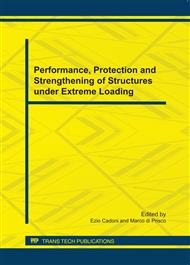p.124
p.130
p.136
p.142
p.148
p.154
p.160
p.166
p.172
Influence of Free Water and Strain-Rate on the Shear Behaviour of Concrete
Abstract:
Shear fracture (mode II) may be observed in concrete structures when subjected to confined or impact loading. Among the different techniques developed to investigate the shear strength of geomaterials, figures the Punch-Through Shear test (PTS test). It consists of a short cylinder with two cylindrical notches made on the lower and upper surfaces. Shear fracture is produced in the ligament due to the displacement of the central zone beside the peripheral zone. An experimental setup has been developed in LEM3 laboratory to measure the shear strength of concrete under quasi-static and dynamic loading. A high-speed hydraulic press allowed reaching strain-rates up to few per second. Steel and aluminium alloy confining rings have been used to induce a confining pressure in the fractured zone. Furthermore, radial notches have been performed in the specimen in order to deduce the radial stress at the ligament surface from the contact pressure between the confining ring and the outer surface of the specimen. The experimental results have been used to discuss the influence of free water and strain-rate on the shear behaviour of concrete.
Info:
Periodical:
Pages:
148-153
Citation:
Online since:
July 2011
Authors:
Price:
Сopyright:
© 2011 Trans Tech Publications Ltd. All Rights Reserved
Share:
Citation:


